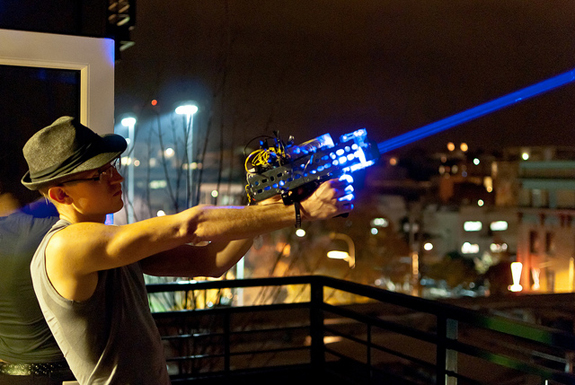The Navy’s Future Is Filled With Laser Guns
The US Navy is driving the push in the development of laser-based weaponry

Pew pew pew. Photo: Flickr user lytfyre
Naval warfare of the future will be chock-full of zapping, burning and melting laser beams, says The Economist.
Drawing on a long history of light-based weapons systems, dating back to at least the ancient Greeks, the modern push for laser weapons “was revived when American strategists began thinking in earnest about the technologies they would need to shoot down nuclear-armed ballistic missiles.”
Unlike bullets or missiles, lasers are particularly well suited for taking down small, swift, highly-maneuverable targets that a physical projectile would struggle to hit. That is, of course, assuming that these small objects can be tracked and locked onto for long enough that the laser, traveling at the speed of light, can do its work. So far, tests have seen ship-mounted lasers take down a small boat and an unmanned aerial vehicle or drone.
The Economist draws up a list of different laser-weapon technologies which either have, or will, come to fruition in the near future:
Fiber lasers, such as BAE System‘s “Tactical Laser System,” are relatively low-powered lasers that could “be useful for frightening off (or burning holes in) small boats that look threatening but wouldn’t warrant a hail of machinegun fire.”
Solid-state lasers, with a bit of work, could be turned into weapons capable of “shoot down high-speed cruise missiles.”
And finally, the big guns, free electron lasers. The Economist reports:
Such lasers are being developed almost exclusively by the American navy because they are too big to fit on planes or trucks. They work by shooting a stream of electrons at high speed through an undulating magnetic field, causing the electrons to emit radiation that coheres to form the beam. As well as being powerful, free-electron lasers have the advantage that they can be tuned to a precise frequency, allowing the beam to be adjusted for different atmospheric conditions. For the moment, however, these lasers are bulky and inefficient, and are probably two decades away from being practical weapons.
Some of these are already in use, some need to be scaled up, and some, like the free electron laser, need a lot of work. But on the long timeline of light-based weaponry, a few decades is but a pittance.
More from Smithsonian.com:
In the Military, Inventiveness of All Kinds Is a Weapon
/https://tf-cmsv2-smithsonianmag-media.s3.amazonaws.com/accounts/headshot/smartnews-colin-schultz-240.jpg)
/https://tf-cmsv2-smithsonianmag-media.s3.amazonaws.com/accounts/headshot/smartnews-colin-schultz-240.jpg)